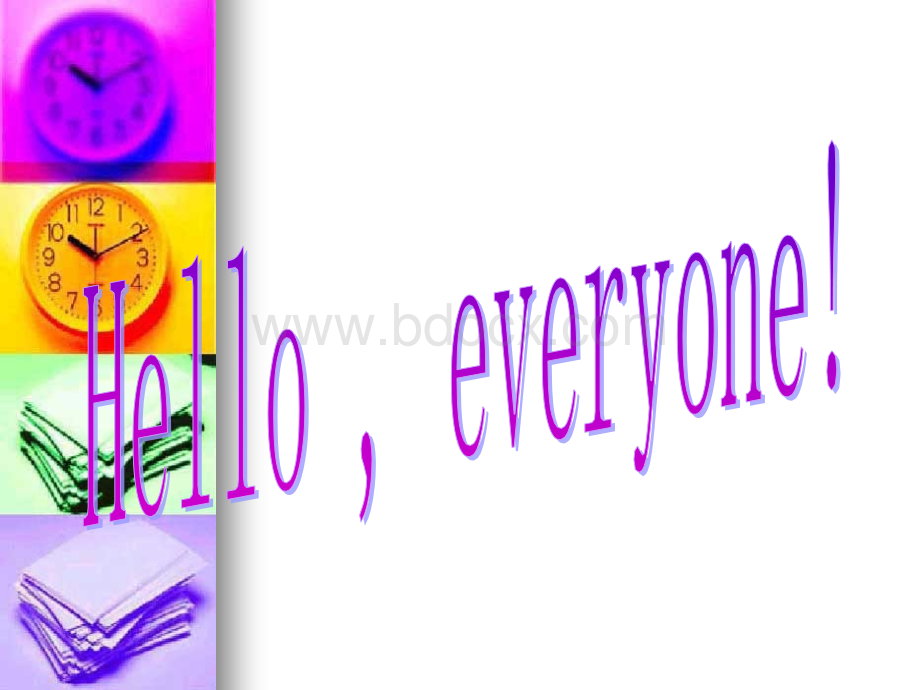小学英语语法形容词和副词详细讲解下载PPT文档格式.ppt
《小学英语语法形容词和副词详细讲解下载PPT文档格式.ppt》由会员分享,可在线阅读,更多相关《小学英语语法形容词和副词详细讲解下载PPT文档格式.ppt(125页珍藏版)》请在冰豆网上搜索。

例如:
TheTimesisaweeklypaper.时代周刊为周刊。
TheTimesispublishedweekly.时代周刊每周发行一期。
4.3用形容词表示类别和整体1)某些形容词加上定冠词可以泛指一类人,与谓语动词的复数连接,如thedead,theliving,therich,thepoor,theblind,thehungry等。
Thepoorarelosinghope.穷人行将失去希望。
2)有关国家和民族的形容词加上定冠词指这个民族的整体,与动词的复数连用,如theBritish,theEnglish,theFrench,theChinese等。
TheEnglishhavewonderfulsenseofhumor.英国人颇有幽默感。
三、形容词和副词的级三、形容词和副词的级形容词和副词有三个等级:
形容词和副词有三个等级:
原级、比较级、最高级原级、比较级、最高级1.原级:
即形容词和副词的原形。
原级:
small,good,pretty,big,manyhard,happily,slowly,quickly程度副词程度副词very,too,so,quite等修饰形容词等修饰形容词和副词的原级。
和副词的原级。
如:
verytall、toohot、socoldquiteinterestingrunquickly程度副词程度副词very,too,so,quite等修饰形容等修饰形容词和副词的原级。
词和副词的原级。
verytall、toohot、socoldquiteinterestingrunquicklyasas,(与与一样)一样)notas(so)as(与(与不一样)中间用原级。
不一样)中间用原级。
Thestoryisasinterestingasthatone.Thequestionisnotas/sodifficultasthatone.形容词的用法1)形容词在句子中通常放在名词前面,形容词+名词,含有“的”意思。
nacleverboy一个聪明的男孩nabluecar一辆蓝色的汽车n注意:
形容词在修饰someone,somebody,something,anything,nothing等不定代词时,需要置于其后。
nsomethingimportant重要的事情nnothinginteresting没有什么有趣的事2)形容词在句子中也常放在系动词之后,名词+系动词+形容词,如:
nTheseflowersarered.这些花是红色的。
(形容词red在句中放在系动词be之后。
)Boblookssmarttoday.今天鲍勃看上去很精神。
3形容词与表示“长、宽、高、重、老、距离”的词连用时,常放在后面。
Iam1.60meterstall.我1米60。
Sheis12yearsold.我12岁。
Exercise1、Sheisa()girl.A、beautifulB、beautyC、beautifully2、Thefoodtastes()A、terriblyB、deliciousC、deliciously形容词的比较级和最高级句型。
形容词的比较级和最高级句型。
1.1.形容词是用来修饰和描述名词,通形容词是用来修饰和描述名词,通常放在常放在名词名词之前之前aabluebluecapcapaabigbigorangeorange形容词既可修饰单数也可修饰复数aaredredstrawberrythreestrawberrythreeredredstrawberriesstrawberries一一.形容词的概念形容词的概念2.形容词可以放在bebe动词之后,用来叙述和说明主语Thissuitisblue.Thesesuitsareblue.Theappleisred.Theapplesarered.3.形容词的类别:
形容词简单形容词:
由单个词构成复合形容词:
由两个或两个以上词构成darkblue(深蓝的)lightgreen(浅绿的)goodlooking(好看的)newborn(新生的)evergreen(常青的)snowwhite(雪白的)bigsmallopenclosedtallshortshortlong4.形容词中的反义词:
BeautifuluglyhappysadillwellYoungoldfastslowtallshortfatthinstrongweakhappysad高的-矮的胖的-瘦的结实的-虚弱的快乐的-悲伤的youngoldnewoldlongshortbigsmall年轻的-年老的新的旧的长的短的大的小的biglittlegoodbadhotcoldwarmcool大的小的好的坏的热的冷的温暖的凉爽的drywetfullemptycleandirtyfastslow干的湿的满的空的干净的脏的快的慢的thickthinlightheavyillwellsweetbitter厚的薄的轻的重的生病的好的甜的苦的noisequietbeautifuluglycleverstupid吵闹的安静的漂亮的丑陋的聪明的愚笨的写出下列形容词和副词的反义词写出下列形容词和副词的反义词1.fast2.tall3.heavy4.empty5.fat6.easy7.clean8.safe9.late10.fat11.cold12.dry13.slowly14.easily15.little16.few17.good18.while副词放在所修饰的动词之后、形容词和副副词放在所修饰的动词之后、形容词和副词之前词之前。
如果前面是行为动词,则后面用副词。
如如:
1.Sheworkshard.(修饰动词)2.Iamverybusy.(修饰形容词)3.Herunstooquickly.(修饰副词)4.Weplayhappily.(修饰动词)副词副词是用来修饰是用来修饰动词、形容词、动词、形容词、其他副词或全句的词,其他副词或全句的词,表示时间、地点、程度、表示时间、地点、程度、状态状态等。
等。
副词的概念副词的概念通常在形容词后加通常在形容词后加-ly变成副词。
变成副词。
slow_real_usual_careful_easy_happy_heavy_angry_slowlyusuallyeasilyheavilyreallycarefullyhappilyangrilyThedogisbiggerthanthemouse.Thehorseisthebiggestofall.Theboyisyoungerthantheman.Thebabyistheyoungestofthethree.bigbiggerbiggestyoungyoungeryoungestJimLiLeiTomLiLeiistallerthanTom.Jimisthetallestofall.¥30¥20¥10Theyellowcoatischeaperthanthepurpleone.Thebrowncoatisthecheapestofthethree.ThedogisbiggerthanthemouseTheboyisyoungerthantheman.LiLeiistallerthanTom.Theyellowcoatischeaperthanthepurpleone.A+be+比较级比较级+than+B形容词比较级句式的结构:
形容词比较级句式的结构:
Thehorseisthebiggestofall.Thebabyistheyoungestofthethree.Thebrowncoatisthecheapest.Jimisthetallestinourclass.主语主语+be+the+最高级最高级+of/in.形容词最高级句式的结构:
形容词最高级句式的结构:
¥30¥20¥10TomLiLeiJimyoungcheaptallJimisstrong.LiLeiis.Tomis.strongerthestrongestThebluecarisnice.Theredcarthebluecar.(红车比蓝车好看)红车比蓝车好看)Thecolourcarofall.(彩色车最好看)(彩色车最好看)isnicerthanisthenicestbigbiggerLookatthepicturesandunderstand看图并理解Lookatthepicturesandunderstand看图并理解bigbiggerbiggestfastLookatthepicturesandunderstand看图并理解fastfasterLookatthepicturesandunderstand看图并理解fastfasterfastestLookatthepicturesandunderstand看图并理解副词n副词(adverb缩写为adv.或ad.)n用来修饰动词、形容词、其他副词,可表示时间、地点、程度、状态等。
n1Thewindisblowingstrongly.风刮的很大。
(副词strongly修饰动词blow,表示程度。
)n2Icanseeclearly.我能看的清。
(副词clearly修饰动词see)n3Itisverylate.天很晚了。
(副词very修饰形容词late)n4Iloveyouverymuch.我很爱你。
(副词very修饰副词much)副词的分类1)时间副词:
表示“事情发生的时间”nnow现在then那时today今天nyesterday昨天2)地点副词:
表示“事情发生的地点、位置。
”nHere这里there那里n3)频率副词:
表示“事情发生的频度”nalways总是usually通常often经常nseldom很少sometimes有时never从不星期日星期一星期二星期三星期四星期五星期六always100%usually75%often50%sometimes25%seldom5%never0%4)程度副词:
表示程度的深浅nmuch很,非常little很少very非常ntoo太quite十分5)疑问副词:
用来引导一个特殊疑问句。
nhow怎样when什么时候where在哪里why为什么副词的用法
(1)副词修饰动词时,通常位于被修饰动词的后面。
nWeshouldstudyhard.我们应该努力学习。
nYouwalktoofast.你走得太快了。
(2)副词修饰形容词时,通常放在形容词的前面。
nTheboyistooyoungtogotoschool.那个小孩子太小,不能去上学。
nMarkTwinisaveryfunnyman.马